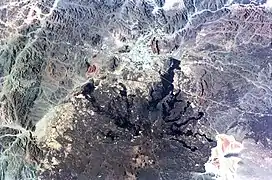| Harrat Rahat | |
|---|---|
 Satellite picture of the northern part of the lava field | |
| Highest point | |
| Elevation | 1,744 m (5,722 ft) |
| Coordinates | 23°5′0″N 39°47′0″E / 23.08333°N 39.78333°E |
| Naming | |
| Native name | حَرَّة رَهَاط (Arabic) |
| Geography | |
| Location | Hejaz, Saudi Arabia |
| Geology | |
| Mountain type | Volcanic field |
| Last eruption | June to July 1256 |
Ḥarrat Rahāṭ[1] (Arabic: حَرَّة رَهَاط) is a volcanic lava field in the Hejazi region of Saudi Arabia. In 1256 CE, a 0.5 km3 (0.12 cu mi) lava flow erupted from six aligned scoria cones, and traveled 23 km (14 mi) to within 4 km (2.5 mi) of the Islamic holy city of Medina; this was its last eruption. There were earlier eruptions, such as in 641 CE, which made finger-like flows to the east of the 1256 CE flow.[2] It is the biggest lava field in Saudi Arabia.[3] Nearby is Al Wahbah crater.
There has been recent increase in seismic activity since 2009.[4]
See also
External links
References
- ↑ "Harrat Rahat". Global Volcanism Program. Smithsonian Institution.
- ↑ "Living on Lava". 25 February 2019.
- ↑ Brown, Glen F.; Schmidt, Dwight L.; Huffman, A. Curtis Jr. (1989). "Geology of the Arabian Peninsula; shield area of western Saudi Arabia".
{{cite journal}}: Cite journal requires|journal=(help) - ↑ Moufti, Mohammed Rashad; Németh, Károly (2016), "Harrat Rahat: The Geoheritage Value of the Youngest Long-Lived Volcanic Field in the Kingdom of Saudi Arabia", Geoheritage of Volcanic Harrats in Saudi Arabia, Cham: Springer International Publishing, pp. 33–120, doi:10.1007/978-3-319-33015-0_3, ISBN 978-3-319-33013-6, retrieved 2022-05-12
This article is issued from Wikipedia. The text is licensed under Creative Commons - Attribution - Sharealike. Additional terms may apply for the media files.
.jpg.webp)


